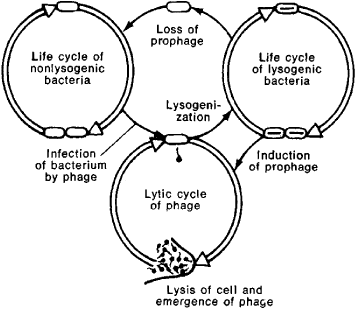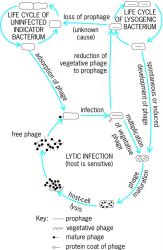Lysogeny
Almost all strains of bacteria are lysogenic; that is, they have the capacity on rare occasions to lyse with the liberation of particles of bacteriophage (see illustration). Such particles can be detected by their ability to form plaques (colonies of bacteriophage) on lawns of sensitive (indicator) bacteria. The genetic determinant of the capacity of lysogenic bacteria to produce bacteriophage is a repressed phage genome (provirus) which exists in the bacterium in one of two states: (1) integrated into the bacterial chromosome (most cases), or (2) occupying some extra-chromosomal location (rare cases).
Bacteriophages which have the potential to exist as provirus are called temperate phages. When the provirus is integrated into the bacterial genome, it is called prophage. When the germinal substance (deoxyribonucleic acid or deoxyribonucleoprotein) of certain temperate phages enters a sensitive bacterium, the outcome may be death (lysis) for the bacterium as a result of phage multiplication, or it may result in the integration of the phage nucleic acid into the host genome (as a prophage), with the formation of a stable lysogenic bacterium. The lysogenic strain is designated by the name of the sensitive strain followed, in parentheses, by the strain of lysogenizing phage, for example, Escherichia coli (λ). Such a bacterium differs from its nonlysogenic ancestor in one very special way: It is immune to lysis by phage homologous to its carried prophage. See Bacteriophage
lysogeny
[lī′säj·ə·nē]Lysogeny
the genetically determined capacity of bacteria to undergo lysis, with the release of a bacteriophage, through a number of generations after direct infection.
The theory of lysogeny was elaborated in 1950 by the French scientists A. Lwoff and A. Gutman, who showed that the lysogenic state is associated with the presence in bacterial cells of a potentially infectious structure called a prophage. In each generation of lysogenic bacteria a very small proportion of the cells (approximately one per million) undergoes lysis, releasing from 70 to 150 particles of temperate phage. The frequency of the conversion of the prophage to an infectious state (prophage induction) may be increased by a number of agents, such as ultraviolet rays.
After infection of the bacterial cell by the temperate phage, the process of infection can develop in either of two directions: the lytic cycle or lysogenization. The lytic cycle, like the cycle in which the bacteria are infected with virulent phages, ends with lysis of the cells and the release of the progeny of the phage into the surrounding medium. In lysogenization, immunity to the infecting phage develops as a result of biosynthetic processes in the cell, phage DNA is incorporated by the bacterial DNA and subsequently replicated together with it as one of its components (prophage), and the bacterium survives and becomes lysogenic (see Figure 1).

The fate of the cell is decided during the first stages of infection and depends chiefly on when immunity develops. Lysogenization may take place if the onset of immunity occurs before the development of the infection reaches the stage that leads irreversibly to lysis. Bacterial genomes may contain the prophages of several different phages simultaneously (multiple lysogeny), in which case the cells will be immune to all of the phages. Changes in several of the properties of the bacterial cell (lysogenic conversion) may result from lysogenization, owing to the acquisition by the bacterium of new genetic information. Artificially produced lysogenic bacteria do not differ in their properties from lysogenic bacteria found under natural conditions.
Recovery, or loss of the prophage, occurs in a small proportion of the progeny of a lysogenic cell. The cells that have lost their prophage give rise to nonlysogenic lines. The frequency of this process may be increased by the action of ultraviolet rays. Thus, lysogeny, a complex form of viral infection in bacteria, may allow for a large number of cell generations between the moment the bacteria are infected with the phage and the lysis of the cells.
REFERENCES
Luria, S., and J. Darnell. Obshchaia virusologiia. Moscow, 1970. (Translated from English.)Ravin, V. K. Lizogeniia. Moscow, 1971.
